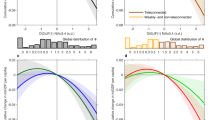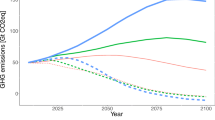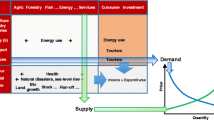Abstract
Climate stabilization efforts must integrate the actions of many socio-economic sectors to be successful in meeting climate stabilization goals, such as limiting atmospheric carbon dioxide (CO2) concentration to be less than double the pre-industrial levels. Estimates of the costs and benefits of stabilization policies are often informed by Integrated Assessment Models (IAMs) of the climate and the economy. These IAMs are highly non-linear with many parameters that abstract globally integrated characteristics of environmental and socio-economic systems. Diagnostic analyses of IAMs can aid in identifying the interdependencies and parametric controls of modeled stabilization policies. Here we report a comprehensive variance-based sensitivity analysis of a doubled-CO2 stabilization policy scenario generated by the globally-aggregated Dynamic Integrated model of Climate and the Economy (DICE). We find that neglecting uncertainties considerably underestimates damage and mitigation costs associated with a doubled-CO2 stabilization goal. More than ninety percent of the states-of-the-world (SOWs) sampled in our analysis exceed the damages and abatement costs calculated for the reference case neglecting uncertainties (1.2 trillion 2005 USD, with worst case costs exceeding $60 trillion). We attribute the variance in these costs to uncertainties in the model parameters relating to climate sensitivity, global participation in abatement, and the cost of lower emission energy sources.




Similar content being viewed by others
References
Ackerman F, Stanton EA, Bueno R (2010) Fat tails, exponents, extreme uncertainty: Simulating catastrophe in DICE. Ecol Econ 69:1657–1665. doi:10.1016/j.ecolecon.2010.03.013
Anderson B, Borgonovo E, Galeotti M, Roson R (2013) Uncertainty in climate change modeling: Can global sensitivity analysis help? Risk Anal 34:271–293. doi:10.1111/risa.12117
Annan JD, Hargreaves JC (2011) On the generation and interpretation of probabilistic estimates of climate sensitivity. Clim Chang 104:423–436. doi:10.1007/s10584-009-9715-y
Archer GEB, Saltelli A, Sobol’ IM (1997) Sensitivity measures, ANOVA-like techniques and the use of bootstrap. J Stat Comput Simul 58:99–120
Bodman RW, Rayner PJ, Karoli DJ (2013) Uncertainty in temperature projections reduced using carbon cycle and climate observations. Nat Clim Chang 3:725–729. doi:10.1038/NCLIMATE1903
Butler MP, Reed PM, Fisher-Vanden K, Keller K, Wagener T (2014) Identifying parametric controls and dependencies in integrated assessment models using global sensitivity analysis. Environ Model Softw 59:10–29. doi:10.1016/j.envsoft.2014.05.001
Clarke L, Edmonds J, Krey V, Richels R, Rose S, Tavoni M (2009) International climate policy architectures: Overview of the EMF22 international scenarios. Energy Econ 31:S64—S81. doi:10.1016/j.eneco.2009.10.013
Collins M, Chandler RE, Cox PM, Huthnance JM, Rougier J, Stephenson DB (2012) Quantifying future climate change. Nat Clim Chang 2(6):403–409. doi:10.1038/NCLIMATE1414
Courtois P (2004) The status of integrated assessment in climatic policy making: An overview of inconsistencies underlying response functions. Environ Sci Pol 7:69–75. doi:10.1016/j.envsci.2003.10.002
Edwards N (2011) Plausible mitigation targets. Nat Clim Chang 1:395–396. doi:10.1038/NCLIMATE1267
Efron B, Tibshirani R (1993) An Introduction to the Bootstrap, Statistics & Applied Probability, vol 57. Chapman & Hall/CRC, New York
den Elzen MGJ, van Vuuren DP, van Vliet J (2010) Postponing emission reductions from 2020 to 2030 increases climate risks and long-term costs. Clim Chang 99:313–320. doi:10.1007/s10584-010-9798-5
EPA (2010). Social cost of carbon for regulatory impact analysis. Tech. rep., U.S. Environmental Protection Agency
EPA (2013) Technical update of the social cost of carbon for regulatory impact analysis. Tech. rep., U.S. Environmental Protection Agency
Gillingham K, Newell RG, Pizer WA (2008) Modeling endogenous technological change for climate policy analysis. Energy Econ 30:2734–2753. doi:10.1016/j.eneco.2008.03.001
Jarvis AJ, Leedal DT, Hewitt CN (2012) Climate-society feedbacks and the avoidance of dangerous climate change. Nat Clim Chang 2:668–671. doi:10.1038/NCLIMATE1586
Joos F, Müller-Fürstenberger G, Stephan G (1999) Correcting the carbon cycle representation: How important is it for the economics of climate change? Environ Model Assess 4:133–140
Keller K, McInerney D (2008) The dynamics of learning about a climate threshold. Clim Dyn 30:321–332. doi:10.1007/s00382-007-0290-5
Keller K, Bolker BM, Bradford DF (2004) Uncertain climate thresholds and optimal economic growth. J Environ Econ Manag 48:723–741. doi:10.1016/j.jeem.2003.10.003
Keller K, Robinson A, Bradford DF, Oppenheimer M (2007) The regrets of procrastination in climate policy. Environ Res Lett 2:014004. doi:10.1088/1748-9326/2/2/014004
Knutti R, Hegerl GC (2008) The equilibrium sensitivity of the earth’s temperature to radiation changes. Nat Geosci 1:735–743. doi:10.1038/NGEO337
Libardoni AG, Forest CE (2011) Sensitivity of distributions of climate system properties to the surface temperature dataset. Geophys Res Lett 38:L22705. doi:10.1029/2011GL049431
Libardoni AG, Forest CE (2013) Sensitivity of distributions of climate system properties to the surface temperature dataset. Geophys Res Lett:40. doi:10.1002/grl.50480
Lima M (2011) Visual Complexity: mapping patterns of information. Princeton Architectural Press, New York
Luderer G, Pietzcker RC, Bertram C, Kriegler E, Meinshausen M, Edenhofer O (2013) Economic mitigation challenges: how further delay closes the door for achieving climate targets. Environ Res Lett 8:034033. doi:10.1088/1748-9326/8/3/034033
McInerney D, Lempert R, Keller K (2012) What are robust strategies in the face of uncertain climate threshold responses Clim Chang 112(3–4):547–568. doi:10.1007/s10584-011-0377-1
Meinshausen M, Smith SJ, Calvin K, Daniel JS, Kainuma MLT, Lamarque JF, Matsumoto K, Montzka SA, Raper SCB, Riahi K, Thomson A, Velders GJM, van Vuuren DPP (2011) The RCP greenhouse gas concentrations and their extensions from 1765 to 2300. Clim Chang 109:213–241. doi:10.1007/s10584-011-0156-z
Nordhaus WD (1994) Managing the Global Commons: The Economics of Climate Change. The MIT Press, Cambridge
Nordhaus W (2007a) Accompanying notes and documentation on development of dice-2007: Notes on dice-2007.delta.v8 as of september 21, 2007. Tech. rep. Yale University
Nordhaus WD (2007b) A review of the Stern Review on the Economics of Climate Change. J Econ Lit XLV:686–702
Nordhaus WD (2008) A Question of Balance: Weighing the Options on Global Warming Policies. Yale University Press, New Haven. Connecticut
Nordhaus WD (2010) Economic aspects of global warming in a post-Copenhagen environment. Proc Natl Acad Sci 107(26):11,721–11,726. doi:10.1073/pnas.1005985107
Nordhaus W D (2013) The Climate Casino: Risk, Uncertainty, and Economics in a Warming World. Yale University Press, New Haven. Connecticut
Nordhaus W D, Boyer J (2000) Warming the world: Economic models of global warming. The MIT Press, Cambridge
NRC (2011) Climate Stabilization Targets: Emissions, Concentrations, and Impacts over Decades to Millennia. Tech. rep., National Research Council
Olson R, Sriver R, Goes M, Urban NM, Matthews HD, Huran M, Keller K (2012) A climate sensitivity estimate using Bayesian fusion of instrumental observations and an Earth System model. J Geophys Res 117:D04103. doi:10.1029/2011JD016620
Parson EA, Fisher-Vanden K (1997) Integrated assessment models of global climate change. Annu Rev Energy Environ 22:589–628
Pizer WA (1999) The optimal choice of climate change policy in the presence of uncertainty. Resour Energy Econ 21:255–287
Plischke E, Borgonovo E, Smith CL (2013) Global sensitivity measures from given data. Eur J Oper Res 226:536–550. doi:10.1016/j.ejor.2012.11.047
Popp D (2004) ENTICE: endogenous technological change in the DICE model of global warming. J Environ Econ Manag 48:742–768
Rogelj J, Hare W, Lowe J, van Vuuren DP, Riahi K, Matthews B, Hanaoka T, Jiang K, Meinshausen M (2011) Emission pathways consistent with a 2∘C global temperature limit. Nat Clim Chang 1:413–418. doi:10.1038/NCLIMATE1258
Rogelj J, McCollum D L, Reisinger A, Meinshausen M, Riahi K (2013) Probabilistic cost estimates for climate change mitigation. Nature 493:79–83. doi:10.1038/nature11787
Saltelli A (2002) Making best use of model evaluations to compute sensitivity indices. Comput Phys Commun 145:280–297
Saltelli A, Ratto M, Andres T, Campolongo F, Cariboni J, Gatelli D, Saisana M, Tarantola S (2008) Global Sensitivity Analysis. The Primer. John Wiley & Sons, Chichester
Schultz P A, Kasting J F (1997) Optimal reductions in CO2 emissions. Energy Policy 25 (5):491–500
Schwanitz V J (2013) Evaluating integrated assessment models of global climate change. Environ Model Softw 50:120–131. doi:10.1016/j.envsoft.2013.09.005
Sobol’ I M (2001) Global sensitivity indices for nonlinear mathematical models and their Monte Carlo estimates. Math Comput Simul 55:271–280
Stanton E A, Ackerman F, Kartha S (2009) Inside the integrated assessment models: Four issues in climate economics. Climate and Development 1:166–184. doi:10.3763/cdev.2009.0015
Stern N (2007) The Economics of Climate Change: The Stern Review. Cambridge University Press, Cambridge
Tang Y, Reed P, Wagener T, van Werkhoven K (2007) Comparing sensitivity analysis methods to advance lumped watershed model identification and evaluation. Hydrol Earth Syst Sci 11:793–817
UN (2011) World population prospects: The 2010 revision. highlights and advance tables. Tech. rep., United Nations
UNEP (2010) The Emissions Gap Report. Tech. rep., United Nations Environment Programme
UNEP (2011) Bridging the Emissions Gap: A UNEP Synthesis Report. Tech. rep., United Nations Environment Programme
Weyant JP, Olavson T (1999) Issues in modeling induced technological change in energy, environmental, and climate policy. Env Model Assess 4:67–85
Acknowledgements
This work was supported by the U.S. Department of Energy, Office of Science, Biological and Environmental Research Program, Integrated Assessment Program, Grant No. DE-SC0005171, with additional support from NSF through the Network for Sustainable Climate Risk Management (SCRiM) under NSF cooperative agreement GEO–1240507 and the Penn State Center for Climate Risk Management. The authors thank William Nordhaus for making the DICE model available, and Alex Libardoni, Chris Forest and Roman Olson for providing their empirical climate sensitivity estimates and advice on their use and interpretation. The DICE model and documentation were accessed on 2/5/2011 from http://nordhaus.econ.yale.edu. Current access to the DICE model is at http://www.econ.yale.edu/~nordhaus/homepage/index.html. The CDICE model code is at https://github.com/mpbutler/CDICE2007. Sobol’ sampling and sensitivity analysis code used in this study are from the MOEA Diagnostic Tool http://www.moeaframework.org. Any opinions, findings, and conclusions expressed in this work are those of the authors, and do not necessarily reflect the views of the National Science Foundation or the Department of Energy.
Author Contributions
All authors jointly designed the study. MPB conducted the experiment and wrote the first draft of the manuscript. All authors edited the manuscript.
Author information
Authors and Affiliations
Corresponding author
Electronic supplementary material
Below is the link to the electronic supplementary material.
Rights and permissions
About this article
Cite this article
Butler, M.P., Reed, P.M., Fisher-Vanden, K. et al. Inaction and climate stabilization uncertainties lead to severe economic risks. Climatic Change 127, 463–474 (2014). https://doi.org/10.1007/s10584-014-1283-0
Received:
Accepted:
Published:
Issue Date:
DOI: https://doi.org/10.1007/s10584-014-1283-0




